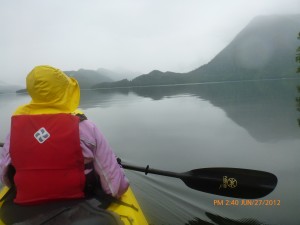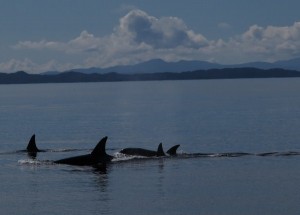Symphonic Journey: The Great Bear Rainforest Video
Too Great A Risk to the Environment: Enbridge Pipeline
Listen to Joan’s May, 2013 blogtalk radio interview that considers ‘kicking up some spray’ in the youtubing world with a blend of word/movement/music: http://www.blogtalkradio.com/ns-writers/2013/05/29/a-live-chat-with-poet-joan-boxall
Seated in the kayak, I’ve got a feeling.
I’m the conductor of my own orchestra.
I plunge my paddle down to the beat,
but something’s out o’synch.
Ah one, ah two, ah three, ah four…
pull and push, push and pull.
I don’t know it yet,
but the orchestra is playing without me.
Me, Me, whose ear and eye go easily astray
in the jade-dipping paint brush…
Once seated in the kayak, I become the conductor of my own Great Bear Rainforest orchestra. That’s my human shortcoming to think that by mounting my podium and plunging into the downbeat of my baton-paddle makes me concertmaster. The tempo and technique with which I pull and push the blades might determine how far I go. But the orchestra? It’s playing without me. I just don’t know it yet. I must attune my ear and eye to its balance and colour. And my blades? Magical paintbrushes on whose palette is every hue of green and blue.
In a four-movement symphony, the first movement develops the theme in a cheerful tempo.
That happy herald is the Hermit Thrush who welcomes us from the woodwinds. His agile song spirals and draws us into a tidal lagoon before we accelerando for the outer islets south of Bella Bella, British Columbia, with fair skies and light wind to our advantage. The Pacific Loon, adds a plaintive falsetto, and the Black Oystercatcher complements with a comical whistle emitted from his orange piccolo. The whirring of White-winged Scoters, the hiss of Pidgeon Guillemots, the sharp keer of Marbled Murrelets, the squeaks and shrieks of Harlequin Ducks and Rhinoceros Auklets all feature in the opening sonata. These are the Goose Islands (Goose, Gosling and Duck) where northwest-wind-battered conifers bonsai in contrast to their sheltered cedar-spruce-yew-hemlock cousins inland.
The first movement continues with the strings. The first violin is the red cedar and the droopier, more fragrant yellow cedar, bows gently in a harmonic melody. Flowering salal rustles as hummingbirds dip and dive on penny-whistle glissandos. The green layers below the low-tide-line are eel grass, feather boa kelp and the giant Pacific bull kelp embodied by violas, cellos and double basses. Bright orange-red-yellow saxophone riffs from soprano to baritone uncover an assortment of seastars: Bat, Vermillion, Leather, Morning Sun, Blood, to the T-Rex of them all: the Sunflower Star. Most conductors of this genre have given up an arm to avoid the Sunflower Star’s bite. Fortunately, most have four or five leftover arms to conduct another day.
Islands are exposed, and so are their beaches. We island hop between Spider and Triquet, Ronald and Manley, and spot seawolf tracks in the sand. A timpani diminuendo mutes their tracks. A pod of transient orcas blow a brassy bugle, and the complex song of a lone humpback resounds just below earshot as the Mothership spirits us away for the evening moorage in a quieter bay. All we see is his regal tail waving farewell and a backdrop of a hundred or more Pacific White-sided Dolphins splashing in gymnastic percussion.
In the second movement, the cloud cover alters the mood as we’re drawn back to Bella Bella. We motor north and east through Troup Passage, paddling into Roscoe Inlet in the mist and mystery of First Nations’ pictograph dots (perhaps marking burial sights), faces, copper shields( a First Nations’ trade commodity),and figures etched in red ocher above the high tide line. The overcast gives a slower, broader feel as we search for our own reflection in the light drizzle that falls in triangle tinkle.The strings vibrate off the high granite peaks whichprovide a launch pad for cascading piano and harp runs that catch the tree line halfway down. Their multiple octaves cover the thousand-meter distance and skim over the surface of the deep-water fjord where there is less inter-tidal life, less birdsong. More introspective.
The third movement is the minuet: the trio of dancers: the people, the place, and the boat, the Columbia III. It’s the socialinteraction we’re having aboard this historic 68-footer, a former mission ship that serviced the isolated logging communities in the days before engines, radios, roads or medical infrastructure. People cried out, ‘The Columbia’s coming!’ They hoped help was on its way. Its third rendition, built in the 1950s, is now completely refurbished with six cozy staterooms from which guests emerge from below decks to the spacious dining room or wheelhouse. We gather for meals, to read and to chat as she, the Columbia III, chugs in her graceful manner, up and down the British Columbia coastlie. Here people have been wed,buried, rescued, and nowadays, tour-guided. It’s the marine environment that stretches with incredible diversity from the outer windswept coastline up passages and channels to inlet fjords where wild salmon provide the interface between marine and land mammals and birds (sea wolves, black, spirit and grizzly bears on down the food chain to ravens, eagles and microbial bacteria) in the estuaries where they connect. This boat provides the backdrop for all the amazing characters throughoutour history …to enhance and hopefully protect the environment she serves.
The fourth movement is a recap. It brings repetition of the principal themes previously set out in the opening woodwind movement, yet there’s embellishment. The Lion’s Mane and Moon jellies ring out gelatinous bells along with tubular sea slugs,otherwise known as nudibranchs. We’ve returned to the outer islands via Louise Channel to Stryker Island and the McMullan Group. There are contrasting themes along with a deeper awareness. We pass an eagle aerie with eaglet inside, or a group of juvenile Common Loons getting life-coaching from one or two adults. It’s a rare sighting of a sea otter who has hauled outon a bed of seaweed for an urchin break.
We’re re-winding back to the Hermit-Thrush hello in the final anchorage of the Tribal Island Group. A pre-breakfast paddle sets Pacific harbour seals sliding off trombones, dolphins hurdling tuned-bar instruments, and a distant diving humpback is the tuba scoobie-doo. There are some swells. The conductor is making good eye contact with peripheral vision; shaping and layering the contours, the textures. There’s a letting go of the note: a tapering, as if with one breath we’re reminded and reassured of the folks who capture the appeal, the question: Is this glorious pristine environment worth saving?
The conductor’s podium isn’t the pit of a halved peach as in a human orchestra, but is as integral a part of the circle of life as all the other players. We’re connected to it and cueing off it. It’s Bach, Mendelssohn, and Tchaikovsky. It’s Haydn, Brahms, Schumann and Dvorak. It’s Saint-Saen’s ‘Carnival of the Animals’; Berlioz’s ‘Symphonie Fantastique’. It’s Verdi’s four-act ‘Aida’. It’s Gershwin’s jazz opera, ‘Porgy and Bess’; it’s Duke Ellington’s big band playing ‘I’m Beginning to See the Light’ simultaneously with ‘Take The A-Train’. It’s rock opera. David Bowie’s ‘Ziggy Stardust’ and Pete Townshend’s ‘Tommy’. Mick Jagger and Pavarotti sharing a duet. It’s Led Zeppelin on guitar, Yo-Yo Ma on cello. It’s the ever-evolving humpback song. It’s the Great Bear Rainforest: so diverse and yet so connected.
There’s synchrony embodied in the sound. Each note, from high to low, is incorporated in the whole, uniting the dynamics of sound (loud-soft), colour (dark-light), brightness (dark-bright) and texture (rough-smooth). It’s all there waiting; intact, temperate. In the inter-tidal zone off the Great Bear Rainforest in British Columbia’s north and central coast region.
Listen to Joan’s May, 2013 blogtalk radio interview that considers ‘kicking up some spray’ in the youtubing world with a blend of word/movement/music: http://www.blogtalkradio.com/ns-writers/2013/05/29/a-live-chat-with-poet-joan-boxall
.
